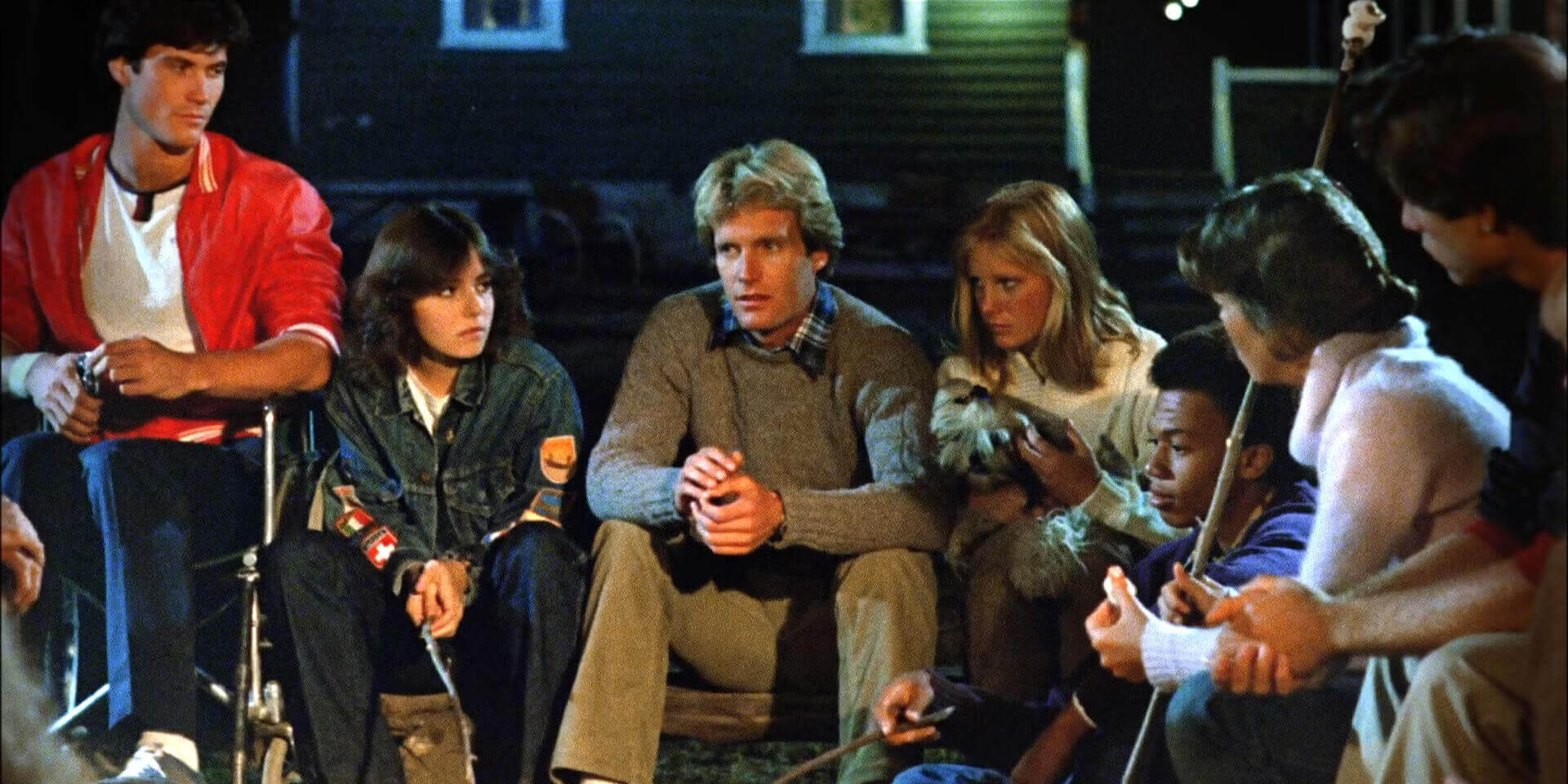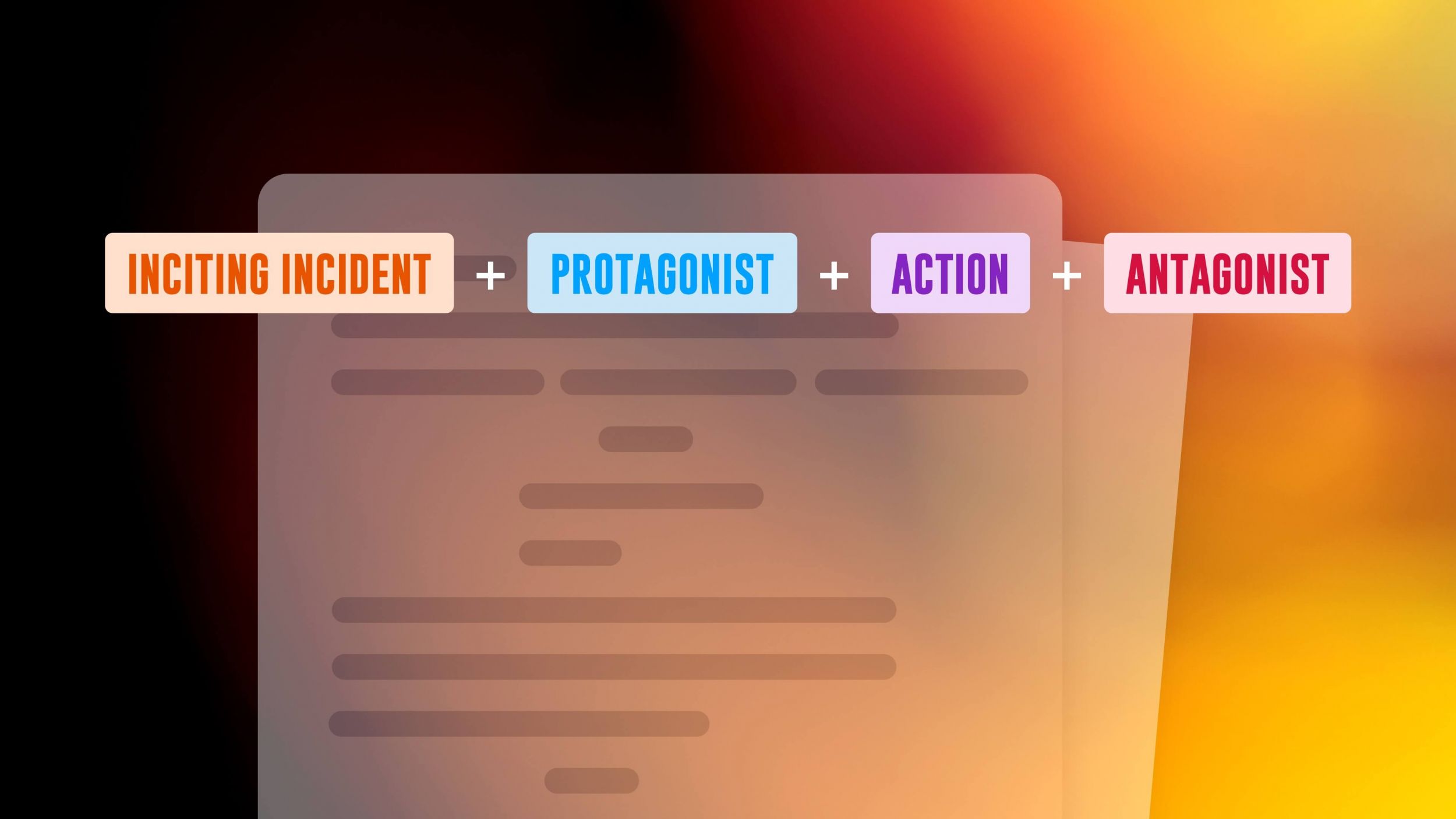Before a writer crafts a screenplay, they usually come up with a logline. At any stage of a production, a logline is a tool used to sell an idea. Movie loglines are short, so writing out a bunch is easy. Writing one that sells, however, is its challenge. In this article, we’ll show you how to write a logline and break down some famous logline examples.
Watch: Anatomy of a Screenplay — Ultimate Guide
FREE Infographic: The Ultimate Formula Behind Perfect Loglines

Download your FREE basic and advanced logline formula.
Just enter your email address and we'll instantly send it to you!
Logline Definition
What is a logline?
A logline, or log line, is a brief (one to two sentence) summary of, TV show or other piece of media that hooks the reader and describes the central conflict of a story.
If someone asks you what your screenplay is about, respond with a logline. We’ll get into how to write a good logline that grabs attention, but before that, let’s ask ourselves, what is a logline? And more importantly, why does every great script start with one? It’s important to note that movie loglines are concise.
Logline vs synopsis
While your logline is a short summary of what your movie is about, your synopsis is a beat-for-beat retelling of your story's plot.
Whether you're crafting a documentary logline or tinkering with loglines for short films, your logline is never the same as your synopsis.
Logline vs tagline
While your logline tells us what we're getting into, the tagline gets us excited (and is almost always a play on words). For more on taglines, check out our article on "What's a tagline?"
The TV logline example for Silicon Valley is "A shy Silicon Valley engineer tries to build his own company," while the tagline is "He's got called company."
While no two TV or movie loglines are alike, inserting your story into a logline template can give your idea direction, especially when learning how to write a great logline. Use the following formula to get started:
Logline Formula
Logline formula in your story
When [INCITING INCIDENT] happens, [OUR PROTAGONIST] decides [TO DO ACTION] against [ANTAGONIST].
How to Write a Logline: A Step-by-Step Guide
1. Create strong protagonists
A beautiful assassin. A hot-headed anchor. A culinary-gifted rat.
The first part of your logline should give us insight into who your movie is about, one of the essential steps in learning how to write a logline for a screenplay.
While you have a great sense of your main character, it's important to focus on the key elements that make your character unique. Usually, two conflicting adjectives can grab our attention and explain who the protagonist is.

Example of a Logline • Napoleon Dynamite
Napoleon Dynamite Example
A listless and alienated teenager decides to help his new friend win the class presidency in their small western high school, all while he must deal with his bizarre family life back home.
Related Posts
What is a Logline Used For?
2. The best loglines are goals
Character studies are fun, but characters are defined by the actions they perform something essential to grasp when figuring out how to write a great logline. A great log line sets up what the character wants. We’ll have to see if they achieve it. The best log line examples pose questions that we'll have to watch play out.
If you wrote a movie log line that stated, "a man sets out to build a robot," it may be a goal, but it is a bit too bland (and possibly too broad).
That same log line can be strengthened by adding a specific, testable goal. "A man sets out to build a robot to win a competition." Immediately, we can visualize a competition and a clear way to benchmark the protagonist's success.

What's a Longline in Film • Django Unchained
Django Unchained Example
With the help of a German bounty hunter, a freed slave sets out to rescue his wife from a brutal Mississippi plantation owner.
Logline Examples with Irony and Conflict
3. Irony is your friend
An airhead blonde goes to Harvard Law School. A Christmas Elf goes to New York City.
Peruse any great logline examples, and you'll be sure to find irony, one of the most effective tools when learning how to write a logline for a screenplay. While irony is the bedrock of any comedy movie logline, it also makes the protagonist's journey as hard as possible.
By pairing opposite personalities together and placing fish out of water, you begin to shape your story.
In The Silence of the Lambs, irony comes through as a serial killer is recruited to capture other serial killers.

Logline Format • The Silence of the Lambs
The Silence of the Lambs
A young F.B.I. cadet must confide in an incarcerated and manipulative killer to receive his help on catching another serial killer who skins his victims.
Logline Examples
4. Movie loglines should have stakes
Is it the end of the world? Will a bomb explode? Is there a dastardly villain? Creating the ultimate villain is no easy feat, but it's easier to achieve if you have strong stakes.
Stakes are great when coupled with a goal–when stakes are increased, it makes our desire to see the whole thing play out even greater. The stakes in Star Wars are of "galactic" proportions.

Sample Loglines • Star Wars: A New Hope
Star Wars: A New Hope
Luke Skywalker, a spirited farm boy, joins rebel forces to save Princess Leia from the evil Darth Vader, and the galaxy from the Empire’s Death Star.
Related Posts
The Best Loglines
5. Don't use character names
Since your characters only exist in your mind's eye, it's important to describe who they are.
People didn't know who Ron Burgundy was before Anchorman... but the log line tells us that he's "San Diego's top-rated newsreader" – which is more important than his name. Of course, names can still be included in titles; the movie is subtitled "The Legend of Ron Burgundy" after all.

Sentence Summary of Ron Burgundy's Life • Anchorman
ANCHORMAN: THE LEGEND OF RON BURGUNDY
In the 1970s, an anchorman's stint as San Diego's top-rated newsreader is challenged when an ambitious newswoman becomes his co-anchor.
This is a classic log line setup driven by role reversal.
Sample Loglines
6. Use active voice
Passive voice is fine in some styles of writing – but it should generally be avoided when writing loglines; it's best to explain how the subject of the sentence acts rather than how an action is performed upon the subject.
Here's an example of a passive voice logline:
Friday the 13th Part 2 (passive voice)
"Five years after the events of the first film, a summer camp next to the infamous Camp Crystal Lake is preparing to open, but the legend of Jason is weighing heavily on the proceedings."

Friday the 13th 2 Logline • Creepy Times at Camp Crystal Lake
The Friday the 13th 2 logline could easily be rephrased to active voice. Check out the sample logline
FRIDAY THE 13TH PART 2 (ACTIVE VOICE)
"The infamous Camp Crystal Lake re-opens five years after the events of the first film... but the legend of Jason weighs heavy on the proceedings."
Logline Examples: From Horror to Comedy
7. The best loglines break the rules
A producer's assistant will pore over loglines all day long to the point where they all sound exactly the same.
While the tips we've outlined should give you structure and direction, what makes movie loglines truly great is riffing on genre conventions.
The Pirates of the Caribbean logline does just that. Although it states character names, it gets across the character with carefully placed quotation marks around the word "Captain." It shifts the inciting incident halfway through the logline. And most importantly, it delivers a twist right at the end of the sentence.

Define Logline • Pirates of the Caribbean
Pirates of the Caribbean
Blacksmith Will Turner teams up with eccentric pirate “Captain” Jack Sparrow to save his love, the governor’s daughter, from Jack’s former pirate allies, who are now undead.
What's A Logline Format?
8. Try using a logline generator
There are tons of tools that can help you generate loglines. Artificial intelligence programs like ChatGPT can serve as logline generators; just type in a prompt and ask them for a list of logline examples.
I asked ChatGPT to generate three loglines for a script about a dog that gets elected president but has to contend with a majority cat House and Senate.
It promptly responded with:
Paws in Power
When a loyal Golden Retriever is unexpectedly elected President of the United States, he must navigate a gridlocked Congress dominated by cats determined to claw back control, proving that bipartisanship can bridge even the deepest divides.
Fetch the Vote
The first canine Commander-in-Chief faces his greatest challenge: uniting a politically polarized nation and taming a feline-controlled legislature intent on toppling his tail-wagging administration.
Bark and Balance
A dog’s dream of leading the free world turns into a political circus as he contends with a crafty cat-led Congress, testing whether charm, wit, and wagging tails can overcome partisan paw-litics.
Whether you’re stuck for ideas or getting tripped up on syntax, a generator is a cool way to brainstorm.
How to Write a Logline: Tips + Sample Loglines
How to write a logline that kills
Have these loglines from popular films not been enough to kickstart your creativity? Let’s review our tips on how to write a good logline that actually sells:
- Describe your protagonist with strong adjectives
- Give your protagonist a clear goal
- Use irony
- Increase the stakes
- Don't be afraid to break convention
- Avoid character names
- Use active voice
- Consider a logline generator
The best loglines take multiple drafts and lots of experimenting, especially when you’re learning how to write a film logline that truly grabs attention. It can also be helpful to visualize what your film or show will look like, especially as you’re exploring how to write a logline for a screenplay that reflects tone and genre.
If you're not sure where to start, check out our article on how to write a screenplay, and read up on the industry standard format that has been used by professionals for decades.
Related Posts
up next
How to write a film treatment
You’ve got your logline—it’s sharp, clear, and compelling. Now what? Before diving into full script pages, many professionals build out a treatment: a detailed summary that expands the logline into a full narrative roadmap.
Our next post breaks down how to write a film treatment that captures tone, structure, and emotional arc—so you can move from idea to screenplay with confidence.
